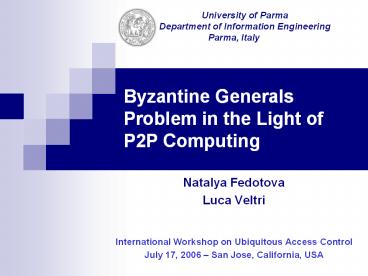Byzantine Generals Problem in the Light of P2P Computing - PowerPoint PPT Presentation
Title:
Byzantine Generals Problem in the Light of P2P Computing
Description:
International Workshop on Ubiquitous Access Control. July 17, 2006 San ... impossibility of agreement on. a common decision. nodes ... impossibility of ... – PowerPoint PPT presentation
Number of Views:119
Avg rating:3.0/5.0
Title: Byzantine Generals Problem in the Light of P2P Computing
1
Byzantine Generals Problem in the Light of P2P
Computing
University of Parma Department of Information
Engineering Parma, Italy
- Natalya Fedotova
- Luca Veltri
- International Workshop on Ubiquitous Access
Control - July 17, 2006 San Jose, California, USA
2
DHT based P2P networks
- Efficient routing performance
- High scalability
- High exact-match accuracy of search
- Simple API
3
DHT based P2P networks
- Main types of attacks
- Incorrect lookup routing
- Incorrect routing updates
- Partition
- Rapid joins and leaves
- Inconsistent behavior
- Storage and retrieval attack
4
Byzantine Generals Problem
- Takes place in distributed computer systems in
the presence of malfunctioning components that
give conflicting information to other parts of
the system - Causes a Byzantine failure, an arbitrary fault
that occurs during the execution of some
algorithm by a distributed computer system, and
as a result - a failure to pass to the next step in the
algorithm - systems inability to correctly implement the
actual algorithm - arbitrary execution of a step different from one
predicated by the algorithm (incorrect hops) - Originally described by L.Lamport, R.Shostak and
M.Pease in 1982, who were the first to apply the
concept of BGP to distributed computer systems
5
Byzantine Generals Problem the original concept
- There are n generals of Byzantine army with their
divisions - They have to reach an agreement on a common plan
of action - These generals are geographically separated and
they have to communicate with each other through
messengers - Some of them are traitors
6
Byzantine Generals Problem the original concept
- To cope with t traitors there must be at least
3t 1 generals and, given the possibility for all
generals to exchange the messages with each
other, must exist some recursive algorithm of
information exchange, equal for all generals, so,
that - all generals make the final decisions
- all loyal generals decide upon the same plan of
action - this final plan of loyal generals must coincide
with final decision of one loyal general at least
7
Byzantine Generals Problem in DHT based P2P
environment
- nodes
- misbehaving nodes
- incorrect routing information
- impossibility of efficient
- hash lookup
- generals
- traitors
- false information
- impossibility of agreement on
- a common decision
It is possible to apply some approaches used in
the case of Byzantine failure
8
Byzantine Generals Problem in DHT based P2P
environment
- Problems of application
- great number of participants
- permanent joins and leaves
- one node cannot contact directly all others
- the number of messages circulating on the network
during the process of traitor detection using the
algorithm by Lamport, Shostak Pease is - Nmsg (n - 1)(n 2) ... (n t 1) (n 1)!
/ t! - increase of the traffic and the overload of the
network
9
Byzantine Generals Problem in DHT based P2P
environment
- Proposed approach
- lets consider P2P network as a number of peer
groups individuated by some principle - each node launches the algorithm only within its
group, and then - Nmsg ((ni - 1)(ni 2) ... (ni ti 1))k
- ni the average number of nodes in one group
formed around one given node i - ti the average number of traitors in one
group - k the number of groups on the network
- for small groups of peers the classical solution
of BGP by Lamport and Shostak becomes efficient
10
Possible criteria to individuate the groups
- the most frequent contacts among the nodes
- common interests
- closeness of identifiers according to
XOR-metric
11
Codat concept as one of possible mechanisms to
individuate the groups
- Codat Code Data
- originally described by JXTA platform developers
- is a unit of information shared and exchanged
within a peer group - means a content that could be either code or data
and is used as a placeholder for any types of
data - is uniquely identified via a unique CodatID and
can belong to only one peer group - contains a document (a content advertisement)
that represents the data it holds
12
Diagrams of Nm change at k increased for t
1/5N (N the number of nodes in the network )
13
Diagrams of Nm change at k increased for t
1/3N (N the number of nodes in the network )
14
Conclusions
- it is possible to apply successfully the
classical solutions for BGP by Lamport and
Shostak in P2P environment - application of these solutions helps to reduce
the number of messages circulating on the network - BUT
- here only completely separated groups are
considered - in this case we deal with the malicious node who
demonstrates poor behavior regarding all the
nodes
15
Future work
- What other mechanisms can we use to individuate a
group? - How can we optimize the algorithm of the traitor
detection process in the case of partially
coinciding groups? - How can we integrate the solutions we have just
presented with some mechanisms of reputation
evaluation?































